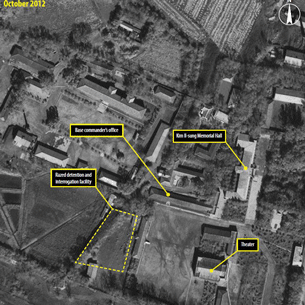North Korea: Move to monitor prison camps
| Publisher | Radio Free Asia |
| Publication Date | 24 October 2012 |
| Cite as | Radio Free Asia, North Korea: Move to monitor prison camps, 24 October 2012, available at: https://www.refworld.org/docid/5090e58114.html [accessed 21 May 2023] |
| Disclaimer | This is not a UNHCR publication. UNHCR is not responsible for, nor does it necessarily endorse, its content. Any views expressed are solely those of the author or publisher and do not necessarily reflect those of UNHCR, the United Nations or its Member States. |
2012-10-24
US groups collaborate to keep watch over North Korea's notorious political prison camps using satellite imagery.
 Satellite imagery shows the detention and interrogation facility (marked by dotted lines) that has been razed at Camp 22's main headquarters area. Photo courtesy of DigitalGlobe and HRNK.
Satellite imagery shows the detention and interrogation facility (marked by dotted lines) that has been razed at Camp 22's main headquarters area. Photo courtesy of DigitalGlobe and HRNK.
A U.S. rights group and a global commercial satellite photography company have teamed up to closely monitor North Korea's political prison camps in a bid to prevent the hard-line state from destroying any evidence of alleged torture and other abuses in the camps.
In their first project, the Committee for Human Rights in North Korea (HRNK), a Washington-based nongovernmental organization, and Colorado-based DigitalGlobe focused on North Korea's Camp No. 22, rejecting reports that the notorious political penal labor facility had been shut down or abandoned.
An analysis of DigitalGlobe images over the last two years, "does not support reports that Camp 22 was shut down or abandoned during 2012," the two groups said in a report responding to recent suggestions that the camp in Hoeryong, North Hamgyong Province, was closed in June.
A North Korean source had told RFA's Korean service in September that North Korean authorities have been working in extreme secrecy to close the site since mid-March last year.
Another source from North Hamgyong Province had told RFA that some guards from Camp 22 were left behind until the end of August to destroy all traces of monitoring and detention facilities.
North Korean authorities, meanwhile, have organized a new cooperative farm at the site with newly transferred people and are busy building regular "family houses," the source said.
The HRNK-DigitalGlobe study however shows continuing harvesting of crops and coal production in the area, making it possible that North Korean authorities have been transferring small sections of prisoners out of Camp 22 and replacing them with a regular workforce from other locations.
The satellite imagery showed the razing of a building that defectors identify as an interrogation center, but "the camp remains operational," the groups said in a joint report entitled "North Korea's Camp No. 22."
'Clear picture'
The report is the first step in a collaborative effort by HRNK and DigitalGlobe "to create a clear picture of the evolution and current state of North Korea's political prison camps."
Under the joint endeavor, DigitalGlobe will provide imagery together with analyses to HRNK, which had put North Korea's penal labor colonies on the map by publishing "Hidden Gulag" in 2003 and "Hidden Gulag Second Edition" in 2012.
The two organizations "will closely monitor North Korea's political prison camps so that any attempts to distort the harsh reality of the camps by destroying evidence will not go unnoticed," the report said.
North Korean state security agency officials who defected to South Korea estimate that the prison camp system holds between 150,000 and 200,000 people, including whole families, for so-called "political crimes."
"The North Korean regime's hiding and distorting the harsh reality of North Korea's unforgiving political prisoner camp system is no longer an option," said Greg Scarlatoiu, HRNK's executive director.
"With constant satellite imagery, we can maintain a watch over these camps even if no outside entry is allowed."
More than 120 states in the United Nations General Assembly expressed "serious concern" in 2011 about "the existence of a large number of prison camps and the extensive use of forced labor" in North Korea, he said.
"If North Korea is trying to make a Potemkin Village out of Camp 22, the world should know," Scarlatoiu said, using a Russian idiom often cited for moves to deceive people into thinking that something is better than it actually is.
Scarlatoiu cautioned however that satellite imagery would not be able to provide views of everything that's happening at the prison camps at any given moment.
"Very often, due to the fact that information coming into and getting out of North Korea is so restricted, sometimes we have to rely on a relatively limited number of sources. It's always very useful to corroborate defector accounts with testimony from those who are still inside the country and with satellite imagery."
Reported by Parameswaran Ponnudurai.
Link to original story on RFA website
